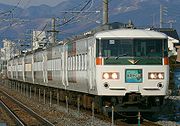.gif)
Kaiji (train)
Encyclopedia
The is a limited express
train service in Japan
operated by East Japan Railway Company
(JR East). It runs mainly between Shinjuku Station
in Tokyo
and Kōfu Station
in Kōfu, Yamanashi
via the Chūō Main Line
.
- Kōfu
(Some trains operate between Tokyo
and Ryūō.)
- Hachiōji
- Matsumoto

Legend
The Kaiji name was revived from 12 December 1966 for use on express services operating between Shinjuku and Matsumoto. These continued until the service was upgraded to limited express service operating between Shinjuku and Kōfu on 13 March 1988.
Smoking was prohibited in all cars from 18 March 2007.
Limited express
A limited express is a type of express train service. It refers to an express service that stops at a limited number of stops in comparison to other express services on the same or similar routes.- Japan :...
train service in Japan
Japan
Japan is an island nation in East Asia. Located in the Pacific Ocean, it lies to the east of the Sea of Japan, China, North Korea, South Korea and Russia, stretching from the Sea of Okhotsk in the north to the East China Sea and Taiwan in the south...
operated by East Japan Railway Company
East Japan Railway Company
is the largest passenger railway company in the world and one of the seven Japan Railways Group companies. The company name is officially abbreviated as JR East in English, and as in Japanese. The company's headquarters are in Yoyogi, Shibuya, Tokyo....
(JR East). It runs mainly between Shinjuku Station
Shinjuku Station
is a train station located in Shinjuku and Shibuya wards in Tokyo, Japan.Serving as the main connecting hub for rail traffic between central Tokyo and its western suburbs on inter-city rail, commuter rail and metro lines, the station was used by an average of 3.64 million people per day in 2007,...
in Tokyo
Tokyo
, ; officially , is one of the 47 prefectures of Japan. Tokyo is the capital of Japan, the center of the Greater Tokyo Area, and the largest metropolitan area of Japan. It is the seat of the Japanese government and the Imperial Palace, and the home of the Japanese Imperial Family...
and Kōfu Station
Kofu Station
is the central railway station managed by East Japan Railway Company , in the city of Kōfu, Yamanashi Prefecture, Japan.- Lines :*East Japan Railway Company **Chūō Main Line*Central Japan Railway Company **Minobu Line...
in Kōfu, Yamanashi
Kofu, Yamanashi
is the capital city of Yamanashi Prefecture in Japan.As of May 1, 2011, the city had a estimate population of 197,540, with 85,794 households. The total area is 212.41 km².-History:Kōfu's name means "capital of Kai Province"...
via the Chūō Main Line
Chuo Main Line
The , commonly called the Chūō Line, is one of the major trunk railway lines in Japan. It runs between Tokyo and Nagoya, although it is the slowest direct railway connection between the two cities; the coastal Tōkaidō Main Line is slightly faster, while the Tōkaidō Shinkansen is the fastest rail...
.
Kaiji
ShinjukuShinjuku Station
is a train station located in Shinjuku and Shibuya wards in Tokyo, Japan.Serving as the main connecting hub for rail traffic between central Tokyo and its western suburbs on inter-city rail, commuter rail and metro lines, the station was used by an average of 3.64 million people per day in 2007,...
- Kōfu
Kofu Station
is the central railway station managed by East Japan Railway Company , in the city of Kōfu, Yamanashi Prefecture, Japan.- Lines :*East Japan Railway Company **Chūō Main Line*Central Japan Railway Company **Minobu Line...
(Some trains operate between Tokyo
Tokyo Station
is a train station located in the Marunouchi business district of Chiyoda, Tokyo, Japan, near the Imperial Palace grounds and the Ginza commercial district....
and Ryūō.)
Hamakaiji
YokohamaYokohama Station
is a main interchange station located in Nishi-ku, Yokohama, Japan. It is the busiest station in Kanagawa Prefecture and the 5th busiest in Japan as of 2004, serving 2.05 million passengers daily.-Lines:Yokohama Station is served by the following lines:...
- Hachiōji
Hachioji Station
is a railway station in the city of Hachiōji, Tokyo, Japan, operated by East Japan Railway Company . It opened on August 11, 1889.-Lines:The Chūō Main Line passes through Hachiōji Station. The Yokohama Line and Hachikō Line terminate here...
- Matsumoto
Matsumoto Station
is a station of East Japan Railway Company and Matsumoto Electric Railway in Matsumoto, Nagano Prefecture, Japan.It is the central station of Matsumoto, the central city of Chūshin Area.-Lines:*East Japan Railway Company **Shinonoi Line**Ōito Line...
Rolling stock used

Kaiji
- E257 seriesE257 seriesThe is a DC electric multiple unit operated by East Japan Railway Company and built jointly by Hitachi, Kinki Sharyo, and Tokyu Car Corporation...
EMUs (since 2001) - 183/189 series183 seriesThe is a limited express EMU introduced in 1972 by Japanese National Railways , and currently operated by East Japan Railway Company and West Japan Railway Company...
EMUs (now used for seasonal additional services only)
Formation
The standard formation of Kaiji (E257 series) consists of nine cars, numbered 3 to 11. Cars 1 and 2 are added to some trains.| ←Shinjuku/Tokyo | Kōfu→ | ||||||||
| 3 | 4 | 5 | 6 | 7 | 8 | 9 | 10 | 11 | |
| N | N | N | N | R | R | G | R | R | R |
Legend
- G: Green class
- R: Ordinary class, reserved
- N: Ordinary class, non-reserved
History
The Kaiji service began on 1 October 1961 as a semi express operating between Shinjuku and Kōfu. This operated until 30 September 1965.The Kaiji name was revived from 12 December 1966 for use on express services operating between Shinjuku and Matsumoto. These continued until the service was upgraded to limited express service operating between Shinjuku and Kōfu on 13 March 1988.
Smoking was prohibited in all cars from 18 March 2007.

